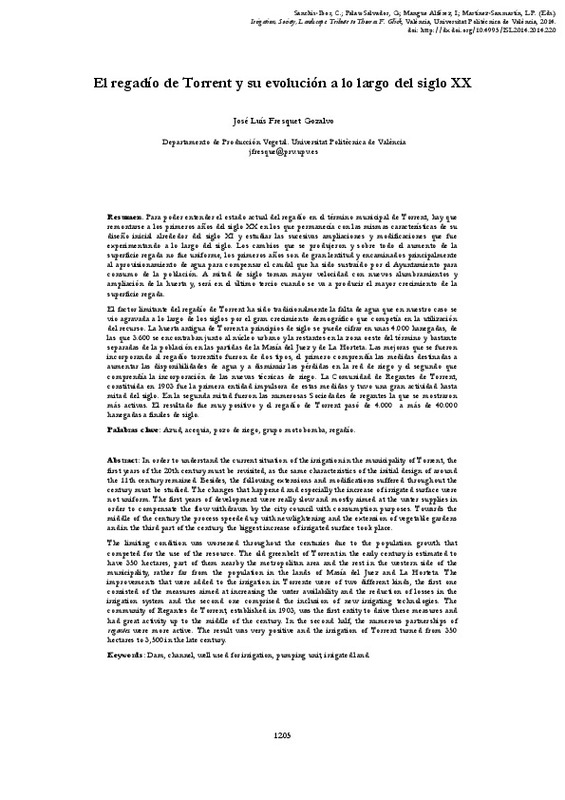|
Resumen:
|
[EN] In order to understand the current situation of the irrigation in the municipality of Torrent, the
first years of the 20th century must be revisited, as the same characteristics of the initial design of around
the ...[+]
[EN] In order to understand the current situation of the irrigation in the municipality of Torrent, the
first years of the 20th century must be revisited, as the same characteristics of the initial design of around
the 11th century remained. Besides, the following extensions and modifications suffered throughout the
century must be studied. The changes that happened and especially the increase of irrigated surface were
not uniform. The first years of development were really slow and mostly aimed at the water supplies in
order to compensate the flow withdrawn by the city council with consumption purposes. Towards the
middle of the century the process speeded up with new lightening and the extension of vegetable gardens
and in the third part of the century, the biggest increase of irrigated surface took place.
The limiting condition was worsened throughout the centuries due to the population growth that
competed for the use of the resource. The old greenbelt of Torrent in the early century is estimated to
have 350 hectares, part of them nearby the metropolitan area and the rest in the western side of the
municipality, rather far from the population in the lands of Masía del Juez and La Horteta. The
improvements that were added to the irrigation in Torrente were of two different kinds, the first one
consisted of the measures aimed at increasing the water availability and the reduction of losses in the
irrigation system and the second one comprised the inclusion of new irrigating technologies. The
community of Regantes de Torrent, established in 1903, was the first entity to drive these measures and
had great activity up to the middle of the century. In the second half, the numerous partnerships of
regantes were more active. The result was very positive and the irrigation of Torrent turned from 350
hectares to 3,500 in the late century.
[-]
[ES] Para poder entender el estado actual del regadío en el término municipal de Torrent, hay que
remontarse a los primeros años del siglo XX en los que permanecía con las mismas características de su
diseño inicial ...[+]
[ES] Para poder entender el estado actual del regadío en el término municipal de Torrent, hay que
remontarse a los primeros años del siglo XX en los que permanecía con las mismas características de su
diseño inicial alrededor del siglo XI y estudiar las sucesivas ampliaciones y modificaciones que fue
experimentando a lo largo del siglo. Los cambios que se produjeron y sobre todo el aumento de la
superficie regada no fue uniforme, los primeros años son de gran lentitud y encaminados principalmente
al aprovisionamiento de agua para compensar el caudal que ha sido sustraído por el Ayuntamiento para
consumo de la población. A mitad de siglo toman mayor velocidad con nuevos alumbramientos y
ampliación de la huerta y, será en el último tercio cuando se va a producir el mayor crecimiento de la
superficie regada.
El factor limitante del regadío de Torrent ha sido tradicionalmente la falta de agua que en nuestro caso se
vio agravada a lo largo de los siglos por el gran crecimiento demográfico que competía en la utilización
del recurso. La huerta antigua de Torrent a principios de siglo se puede cifrar en unas 4.000 hanegadas, de
las que 3.600 se encontraban junto al núcleo urbano y la restantes en la zona oeste del término y bastante
separadas de la población en las partidas de la Masía del Juez y de La Horteta. Las mejoras que se fueron
incorporando al regadío torrentito fueron de dos tipos, el primero comprendía las medidas destinadas a
aumentar las disponibilidades de agua y a disminuir las pérdidas en la red de riego y el segundo que
comprendía la incorporación de las nuevas técnicas de riego. La Comunidad de Regantes de Torrent,
constituida en 1903 fue la primera entidad impulsora de estas medidas y tuvo una gran actividad hasta
mitad del siglo. En la segunda mitad fueron las numerosas Sociedades de regantes la que se mostraron
más activas. El resultado fue muy positivo y el regadío de Torrent pasó de 4.000 a más de 40.000
hanegadas a finales de siglo.
[-]
|








